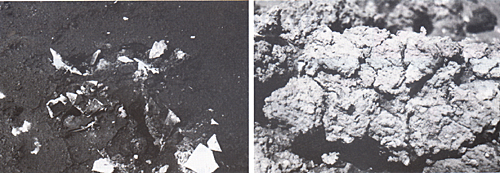
[ M.X.#1 Description and Benefits ] [ Material Safety Data Sheet ]
M.X.#1 - WHAT IS "Probiological Remediation Technology"?
Probiological Remediation Technology (PRT) is a very cost effective bioremediation method that is gaining in popularity in oilfield, industrial and marine applications.
It uses organic compounds and nutrients to promote the detoxification and repair of troubled environments, and works well in many applications. PRT has been successfully applied toward the clean-up of tank bottom materials, crude oil, disposable pits, waste oil pits, surface and ground water contamination, drilling muds, refinery wastes and other environmental problems.
Problems associated with organically-based waste, such as petroleum products, are efficiently reduced or completely eliminated from the environment through biological processes. Degradation of petroleum products by micro-organisms involves converting energy stored as petroleum hydrocarbon chains into energy forms such as water, carbon dioxide, cellular bio-mass, organic matters, organic acids, and other organic compounds and elements. However, this process not only involves biological reactions, but also many non-biological or abiotic reactions as well.
Probiological Remediation processes utilize beneficial organic materials to create an environment in which micro-organisms can perform their natural remediation functions. These functions can be referred to as Abiotic Processes, whether they be chemical changes or other controlling factors, such as temperature, moisture, or aeration. As a result, an environment is promoted that supports the growth of contaminant-degrading organisms.
Environments are detoxified through the use of organic buffering agents, highly available organic microbial residues, and elements which are required for proper environmental control. Toxic compounds are buffered or neutralized by the probiological constituents, enabling the target organisms to better attack and degrade harmful compounds in a more controlled environment.
 |
|
|
LEFT: An on-site photograph of tank bottom materials generated from crude oil storage tanks at an Exxon facility near Vanderbilt, TX., in 1992. |
RIGHT: The same materials one day after the administration of the first probiological remediation treatment. |
Probiological materials provide valuable nutrients and oxygenated compounds which, under toxic conditions, may be unavailable or microbial assimilation. These natural substances are comprised of complex humic materials loaded with 6 and 5 carbon ring structures, oxygen, and oxygen-hydrogen groups. They assist in the degradation and mineralization of petroleum-based chemicals abiotically and biotically, transforming complex organic molecules and carbon chains into more favorable molecules for microbial degradation.
The transformation is accomplished partly by a chemical mechanism called chelation, which involves bonding an organic compound to a single element or another compound at several contact points rather than at a single point. As a molecular level, this is very beneficial.It has been observed that refined petroleum products actually go through an abiotic transformation in which the organic complexes added to petroleum polluted environments lengthen hydrocarbon chains and remove side chains from alicyclic and polyaromatic carbon chains, allowing for easier microbial breakdown of petroleum hydrocarbons.
Another feature of the complexing process is the decrease in volatilization of the smaller-chain hydrocarbons, as well as the tie-up of reactive and harmful metals, such as sodium and chlorine. Because the hydrocarbon chains are lengthened (complexed with the organic compounds) the contaminant structure is less volatile and cannot readily escape into the atmosphere. Hydrocarbon side chains, which normally inhibit microbial degradation processes, are removed and complexed as well. Heavy metals are chelated or complexed to the organic compounds.
The result is a complexed metal that cannot harm microbes because it has been entrapped by an organic compound. The task can be accomplished economically and practically, but industry must at least address environmental concerns and begin the process.